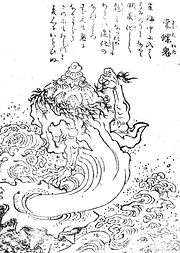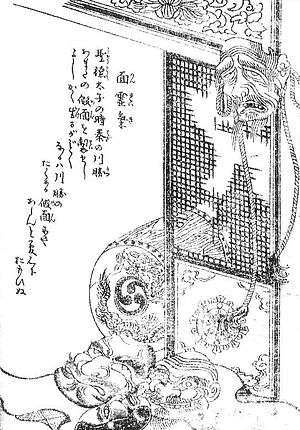Gazu Hyakki Tsurezure Bukuro
Hyakki Tsurezure Bukuro (百器徒然袋, "The Illustrated Bag of One Hundred Random Demons" or "A Horde of Haunted Housewares") is the fourth book in Japanese artist Toriyama Sekien's famous Gazu Hyakki Yagyō tetralogy. A version of the tetralogy translated and annotated in English was published in 2016.[1] The title is a pun; "hyakki," normally written with the characters "hundred" and "oni," is instead written with "hundred" and "vessels." This hints that the majority of the yōkai portrayed in its pages are of the variety known as tsukumogami, man-made objects taken sentient form.[2] Hyakki Tsurezure Bukuro is preceded in the series by Gazu Hyakki Yagyō, Konjaku Gazu Zoku Hyakki, and Konjaku Hyakki Shūi.
Published in 1781, it was inspired in part by Tsurezuregusa (Tales in Idleness), a 14th-century essay collection by the monk Yoshida Kenkō.[3] The book takes the form of a supernatural bestiary of yōkai. Unlike previous books in the series, the majority of Hyakki Tsurezure Bukuro's yōkai appear to be of Sekien's own creation, based on turns of phrase or stories from Tsurezuregusa and other works of literature. Also unlike the other books in the series, Hyakki Tsurezure Bukuro has a rudimentary narrative framework, described as the record of a strange dream in early printings (the third printing omits this introduction).[4]
The book is compiled in three sub-volumes: Jō, Chū, and Ge (literally "top," "middle," and "bottom," but generally translated as first, second, and third volume in English.) The imagery below is from the third printing of the book.
List of creatures
First Volume
Second Volume
 Yarikechō (ja:槍毛長), Koinryō (ja:虎隠良), and Zenfushō (ja:禅釜尚) Zenfushō is a kettle tsukumogami which holds a clawed staff called koinryō. It is pictured alongside monsters called Yarikechō and Koinryō.
Yarikechō (ja:槍毛長), Koinryō (ja:虎隠良), and Zenfushō (ja:禅釜尚) Zenfushō is a kettle tsukumogami which holds a clawed staff called koinryō. It is pictured alongside monsters called Yarikechō and Koinryō. Kurayarō (ja:鞍野郎)
Kurayarō (ja:鞍野郎)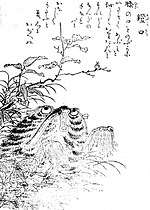
 Taimatsumaru (ja:松明丸)
Taimatsumaru (ja:松明丸) Burabura (不々落々)
Burabura (不々落々) Kaichigo (ja:貝児)
Kaichigo (ja:貝児) Kami-oni (ja:髪鬼)
Kami-oni (ja:髪鬼) Tsunohanzō (ja:角盥漱)
Tsunohanzō (ja:角盥漱) Fukuromujina (ja:袋貉)
Fukuromujina (ja:袋貉)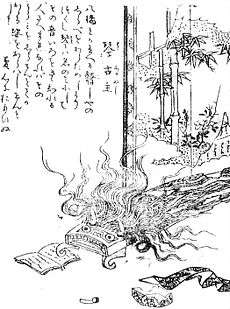 Kotofurunushi (ja:琴古主)
Kotofurunushi (ja:琴古主)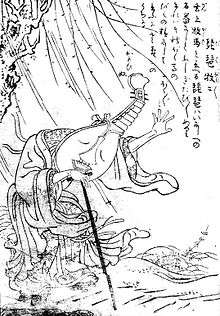 Biwabokuboku (ja:琵琶牧々)
Biwabokuboku (ja:琵琶牧々) Shamichōrō (ja:三味長老)
Shamichōrō (ja:三味長老) Eritategoromo (ja:襟立衣)
Eritategoromo (ja:襟立衣) Kyōrinrin (ja:経凛々)
Kyōrinrin (ja:経凛々)
 Mokugyodaruma (ja:木魚達磨)
Mokugyodaruma (ja:木魚達磨) Nyoijizai (ja:如意自在)
Nyoijizai (ja:如意自在)
 Hahakigami (箒神)
Hahakigami (箒神) Minowaraji (ja:蓑草鞋)
Minowaraji (ja:蓑草鞋)
Bibliography
- "Hyakki Tsurezure Bukuro (3rd Edition), National Diet Library of Japan". Retrieved 2017-03-02.
See also
| Wikimedia Commons has media related to Gazu Hyakki Tsurezure Bukuro. |
References
- Yoda, Hiroko; Alt, Matt (2016). Japandemonium Illustrated: The Yokai Encyclopedias of Toriyama Sekien. Dover Publications. ISBN 978-0-486-80035-6.
- Yoda, Hiroko; Alt, Matt (2016). Japandemonium Illustrated: The Yokai Encyclopedias of Toriyama Sekien. Dover Publications. p. 234. ISBN 978-0-486-80035-6.
- Yoda, Hiroko; Alt, Matt (2016). Japandemonium Illustrated: The Yokai Encyclopedias of Toriyama Sekien. Dover Publications. p. 237. ISBN 978-0-486-80035-6.
- Yoda, Hiroko; Alt, Matt (2016). Japandemonium Illustrated: The Yokai Encyclopedias of Toriyama Sekien. Dover Publications. p. 234. ISBN 978-0-486-80035-6.













